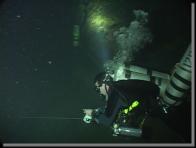Cenote X-lakah
|
|
|
|
|
All photos and text by Jitka Hyniova, unless noted
|
|
|
|
|
|
|
|
|
 |
|
Cenote Xlakah as captured by National Geograpgic photographer in 1959. |
|
|
About 15 miles north of ancient city of Merida, still mostly hidden in Yucatan's dry and dusty jungle, lays one of the most amazing urban centers of the mysterious Mayan civilization. Dzibilchaltun archaeological zone in it's 20 square miles contains pyramids, temples, and the striking white causeway - "sacbe", in places 8 feet high and as wide as a modern four lane highway.
Near Dzibilchaltun's Central Plaza and surrounded by perhaps 4 thousand years old pyramidal structures shines the blue eye of a sacred well. Cenote Xlacah, one of thousands of cenotes or sinkholes scattered over the face of the Yucatan Peninsula has seen its share of intruders.
|
|
 |
|
Temple of Seven Dolls at Dzibilchaltun Archeological Site. |
|
|
 |
|
Cenote Xlakah in November 2001. |
|
|
|
|
|
|
|
|
 |
|
Jakub scootering through the first salt water layer. Fresh and salt water are perfectly stratified forming reflective surface on the interface. |
|
|
Human bones found during the National Geographic archeological expedition in the late 50s testify about ages old religious sacrifices, drowning and murder victims. This expedition also sent the first divers to explore the Xlacah's underwater secrets. Divers entered the enormous cavern and descended to the depth of about 120 feet where they discovered a low-arched black tunnel. During several months of intensive work in the cavern they were able to recover human and animal bones, thousands of pieces of Mayan pottery, tools, jewelry and figurines. On one of their dives they were able to penetrate about 50 feet into the tunnel and to the depth of about 140 feet. After this dive and despite abiding all the then known procedures of safe diving, both divers suffered severe decompression sickness and after several attempts of hyperbaric treatment in makeshift recompression chambers in Merida, they had to be airlifted and treated in Navy chamber in Florida. |
|
 |
|
Divers in the second salt water layer. |
|
|
|
|
|
|
|
|
|
 |
|
Diver moving from salt to fresh water layer. |
|
|
After four decades of its surface being disturbed but by bathers seeking the coolness of the sacred waters, Xlacah again became a center of divers' attention in the late 90s. Between 1998 and 2001, invited by the Government of the State of Yucatan, several teams of cave divers extended the old line to the penetration of about 4000 feet and collected survey data and numerous biological and hydrological samples.
Initially huge 50-60 feet wide, 20-30 feet tall and 170 feet deep passage leads through two duck-unders at depth of 180-190 feet characterized by fresh-salt water interface. Numerous white blind cave fish and cave shrimp swarmed in divers light beams.
Exploration of Xlacah's tunnel didn't confirm original expectations of the passage leading all the way to the Gulf of Mexico but it probably is the longest known underwater cave passage in the State of Yucatan. |
|
 |
|
Sherry carrying one of the 200w video lights lovingly nicknamed "The Brick". |
|
|
|
|
|
|
|
|
|
 |
|
Jakub reading his tables during 50 foot deco stop. |
|
|
 |
|
Jakub surveying walls of the main passage. |
|
|
 |
|
Divers scootering back. |
|
|
|
|
|
|
|
|
|
 |
|
Diver and his gear during 1959 National Geographic expedition (photo National Geographic). |
|
|
 |
|
Diver and his gear in 2001. |
|
|
 |
|
The beautiful view in the cavern zone helped with long deco times. |
|